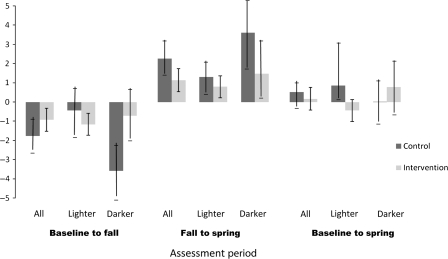Figure 2.
Changes in skin pigmentation among intervention and control students from baseline to fall, fall to spring, and baseline to spring. Pigmentation was assessed by use of a DermaSpectrometer on a subgroup of 378 students (178 in the intervention group and 200 in the control group) during the three assessment periods throughout a school year. We assessed skin pigmentation at a child's forehead as a representative anatomical site that would be protected by hat use. An increase in the DermaSpectrometer readings denotes an increase in melanin, resulting in darkening of the skin. Lighter-skinned students are students with a baseline DermaSpectrometer reading (range = 0–100) that was less than or equal to the median of 20 in the control group and the intervention group. Darker-skinned students were students with a baseline DermaSpectrometer reading (range = 0–100) that is greater than the median of 20 in the control arm and the intervention arm.

